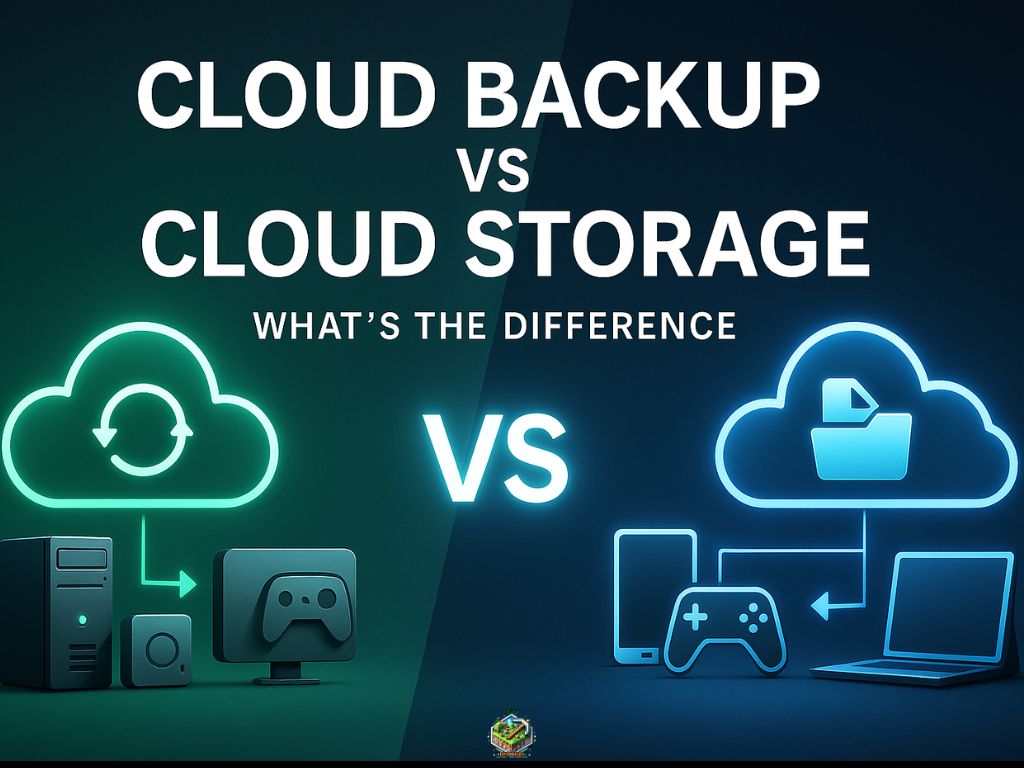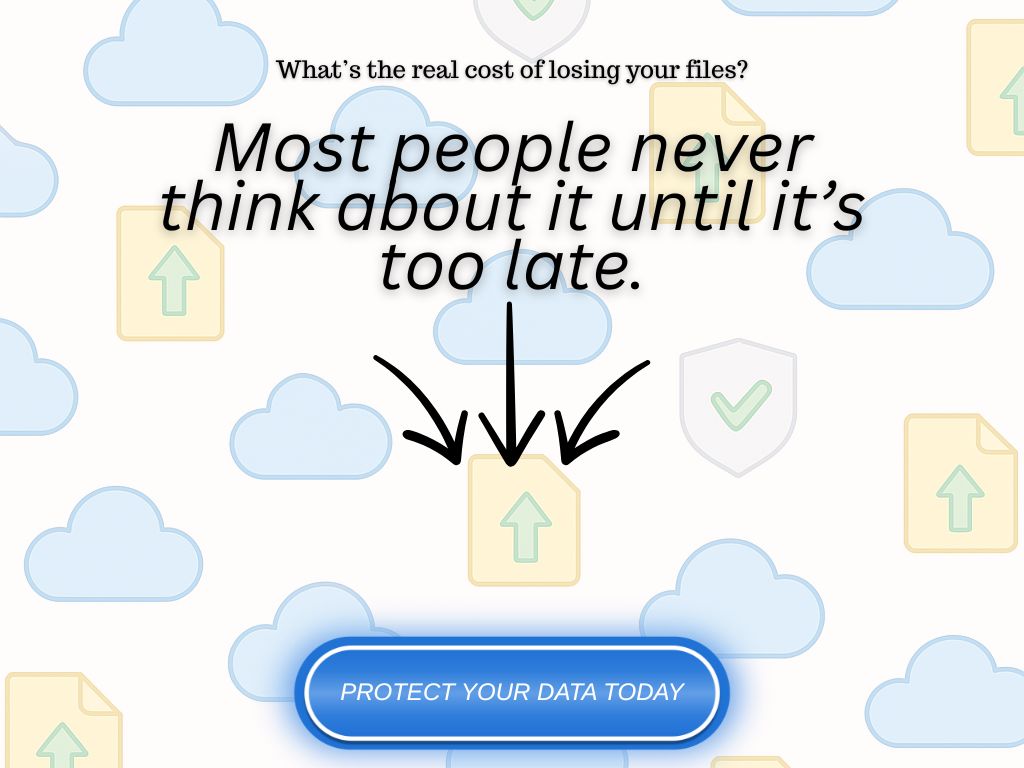Cloud services are everywhere but the terminology around them isn’t always clear.
“Cloud storage” and “cloud backup” are often used interchangeably, even though they serve very different purposes. And while both involve storing data off your device, how they work, what they’re designed to do, and when to use them are not the same.
This article breaks down the difference between cloud storage and cloud backup in simple terms, so you can decide what makes sense for your needs. If you rely on digital files for work, media, or gaming, understanding this distinction can help you avoid gaps in protection and make smarter choices about how your data is handled.
⚡ Key Takeaways
- Cloud storage and cloud backup are not interchangeable, they serve different purposes.
- Storage tools are built for sync and access; backup tools are designed for recovery and protection.
- Relying on cloud storage alone can leave you exposed to accidental deletions or file corruption.
- Cloud backup captures version history and deleted files that storage platforms often can’t restore.
- Most users benefit from using both: storage for active access, backup for long-term safety.
- Understanding the difference helps prevent false confidence and data loss.
Affiliate Disclaimer: Some links on this site are affiliate links. If you buy through them, we may earn a small commission, at no extra cost to you. Please do your own research before making a purchase.

What Is Cloud Storage?
Cloud storage is a service that lets you upload and store files on remote servers, so you can access them from anywhere with an internet connection.
These services are designed to make file access, syncing, and sharing easy across multiple devices. Whether you’re working across laptops, phones, or desktops, cloud storage helps keep your files consistent and up to date.
Popular platforms like Google Drive, Dropbox, OneDrive, and iCloud fall into this category. You can upload documents, images, videos, or any personal files, and retrieve them later through a browser or app.
Cloud storage is ideal for:
- Keeping important files available across devices
- Collaborating with others on shared folders
- Storing working files you frequently update or access
It works in real time meaning when you change a file on one device, it updates everywhere else almost instantly. But it’s important to note: cloud storage is not built for long-term file recovery or automated backups. It’s built for access and sync.
What Is Cloud Backup?
Cloud backup is a service that automatically copies selected files or folders from your device to a secure, off-site location with the specific goal of preserving your data for recovery.
Unlike cloud storage, which is built for access and syncing, backup tools are designed to run in the background on a set schedule. They capture snapshots of your data over time, so if something goes wrong whether it’s accidental deletion, hardware failure, or corruption you can restore the affected files from a previous version.
Most cloud backup services allow you to:
- Choose which folders to protect
- Set how often backups run
- Restore previous versions of files
- Recover deleted files, even after they’re removed from your device
These services aren’t meant for frequent editing or real-time collaboration. Their primary function is protection: quietly keeping your data safe, up to date, and restorable when needed.

The Core Difference: Sync vs Recovery
While cloud storage and cloud backup both involve saving files online, the way they operate and what they’re designed to protect you from is completely different. This isn’t just a technical distinction, it determines whether your data is truly safe or merely synced. If you’re unsure which one you’re using, the table below breaks down the key differences in how each service handles your files.
| Feature / Function | Cloud Storage | Cloud Backup |
|---|---|---|
| Primary Purpose | Sync and access across devices | Data protection and recovery |
| How It Works | Mirrors files in real time | Creates scheduled copies of selected folders |
| File Changes | Updates reflect instantly everywhere | Changes are saved, but older versions are kept |
| File Deletion | Deleted files disappear from all devices | Deleted files can be recovered (if versioning is on) |
| Version History | Limited or manual in most platforms | Typically automatic and continuous |
| Designed For | Real-time editing, collaboration, portability | Set-it-and-forget-it recovery safety net |
| 💡 Quick Takeaway: Cloud storage keeps your files in sync. Cloud backup keeps them safe even when something goes wrong. | ||

When to Use Cloud Storage vs Cloud Backup
Cloud storage and cloud backup aren’t competing tools, they’re built for different jobs. Understanding when to use each one helps you protect your data without overcomplicating your setup.
Use Cloud Storage When You Need:
- Access to files across multiple devices
- Real-time syncing between desktop, mobile, and web
- Quick edits, uploads, and file sharing
- Collaboration with others in a shared workspace
- A central location for active, working files
Cloud storage is best for files you’re actively using. If you’re moving between devices, editing documents, or working with media you regularly update, cloud storage makes that process seamless. It’s fast, flexible, and designed for access not protection.
Use Cloud Backup When You Need:
- Protection against accidental deletion or file corruption
- Scheduled, automated backups of important files or folders
- A way to recover previous versions of a file
- Off-device recovery if your hardware fails or is lost
- Long-term safety without relying on manual saves
Cloud backup is built for stability and recovery. It runs quietly in the background, capturing copies of your data over time even if you’re not thinking about it. It doesn’t overwrite your files or mirror your mistakes. It just keeps you covered.
For users who manage large media libraries, personal projects, or sensitive data, backup provides a kind of insurance that cloud storage simply wasn’t designed to offer.
Can You Use Both?
Yes and in most cases, you should.
Using cloud storage for everyday file access, and cloud backup for long-term protection gives you the best of both worlds. You stay productive without sacrificing safety.
Even for gamers, creators, or PC users with custom workflows, the right combination of these tools makes it easier to keep creating and worry less about what could go wrong.

Why the Difference Matters (Especially for PC Users and Gamers)
On the surface, cloud storage and cloud backup might feel similar. But if you confuse one for the other, you could end up with a false sense of security and zero way to recover your data when it counts.
Many users assume that saving files to a synced folder is the same as having a backup. It’s not. If you delete something, or if a file becomes corrupted, that change is instantly synced across all devices. The result? It’s gone. And unless you’ve set up an actual backup solution, there’s no way to get it back.
For PC users, especially gamers and content creators, this difference matters even more.
If you’re working with large files like gameplay recordings, edited videos, downloaded assets, or creative projects they’re often stored outside the default directories that platform-specific cloud tools protect. That means if your system fails or a file is accidentally deleted, there’s no built-in recovery option unless you’ve configured a dedicated backup.
This isn’t just about avoiding disaster, it’s about control.
Cloud backup gives you the ability to restore data on your terms. Cloud storage doesn’t.
Understanding which tool you’re using and what it’s actually doing can save you hours of frustration, or worse, the permanent loss of work you can’t recreate.

Cloud Backup vs Cloud Storage: Can You Use Both?
Absolutely and for most people, it’s the smartest option.
Cloud storage and cloud backup aren’t competing tools. They solve different problems. One gives you convenience, the other gives you protection. Used together, they create a flexible, reliable system for managing your data.
Here’s how they can work side by side:
- Cloud storage keeps your active files accessible, the ones you edit, share, and sync across devices.
- Cloud backup protects the files you can’t afford to lose whether or not you access them often.
This combination works especially well for people who create and store large files: streamers, editors, developers, designers, or gamers capturing gameplay. You might store project files in a cloud drive for fast access, while a backup tool quietly saves versions in the background in case something goes wrong.
You don’t need complex setups to make this work. Just clarity: Use storage for speed. Use backup for safety.

Choosing the Right Solution for Your Needs
The right choice between cloud storage and cloud backup isn’t about features, it’s about function.
If you’re storing files online, the question isn’t “Which service is better?”
It’s “What outcome am I expecting from this?”
Start with what you actually need to protect
Cloud storage is built for convenience syncing active files, accessing them across devices, and sharing when needed. But it doesn’t create a historical record of your data. If you delete a file, it’s gone unless you’ve manually backed it up elsewhere.
Cloud backup is built for recovery. It captures copies in the background, stores previous versions, and holds onto deleted files for a time. But it’s not made for quick edits or real-time collaboration.
So ask yourself:
- Are these files meant to be worked on, or simply protected?
- Would losing them mean lost progress or lost time?
- Do you need to access them everywhere, or just make sure they’re never gone?
Think in layers, not silos
This isn’t a binary decision. In many cases, using both is the most reliable setup.
For example:
- You might store your current projects in a cloud drive for easy access
- While a backup service quietly protects the folders you don’t touch every day but still care about
It’s a simple division:
- Use storage to stay productive
- Use backup to stay protected
This mindset matters whether you’re managing spreadsheets, recorded footage, config files, or creative work. Even gamers and PC users often have assets saved outside default sync folders making backup the only layer that prevents permanent loss.
Bottom line? Clarity beats assumptions
The worst-case scenario is thinking you’re protected when you’re not. That happens when you confuse syncing with backing up.
Choosing the right service starts by understanding what each one actually does and making sure that aligns with what you’re counting on it to do.
Conclusion:
Most people don’t lose data because they ignored the cloud, they lose it because they misunderstood how the cloud works.
Cloud storage and cloud backup serve two different roles. One gives you access. The other gives you insurance. Knowing which one you’re using and what it’s designed to do is the difference between files that are synced, and files that are actually protected.
It’s not about choosing the most advanced tool. It’s about making sure the tool you already use isn’t leaving gaps you didn’t notice.
Now that you know the difference, you can build a setup that works not just when everything goes right, but when something goes wrong.

Frequently Asked Questions (FAQs)
Is cloud storage the same as cloud backup?
No, they may both store files online, but they work differently. Cloud storage syncs files between devices for access and editing. Cloud backup saves scheduled copies for recovery if something goes wrong. One mirrors your current state, the other protects your history.
Can I use cloud storage as a backup solution?
Not reliably. While you can store files in a cloud drive, true backup involves versioning, deleted file retention, and recovery options features most cloud storage platforms weren’t built to handle.
What happens if I delete a file from cloud storage?
In most cases, it disappears from all synced devices. Some services offer a short-term trash or recovery window, but if you’re relying only on sync, deletion is often permanent unless you act quickly.
Do I really need both cloud storage and cloud backup?
In many cases, yes. Cloud storage gives you fast access to files you’re working on. Cloud backup gives you long-term protection for files you can’t afford to lose. They solve different problems and together, they cover more ground.
Which is more secure: cloud storage or cloud backup?
Both can be secure, depending on the provider. Look for end-to-end encryption, two-factor authentication, and a strong privacy policy regardless of whether it’s a storage or backup service.
Can I recover deleted files with cloud storage services?
Sometimes but only within limits. Cloud storage platforms may keep deleted files in a recycle bin for a short period. After that, recovery is unlikely. Cloud backup services usually retain deleted files for longer and offer more reliable version history.
What’s the best backup method for large files or creative projects?
Use a dedicated cloud backup service with high storage limits and versioning support. Storing large media, archives, or project files often exceeds what basic sync tools are designed for. A backup solution handles this more reliably especially if file recovery matters more than file sharing.



0 Comments